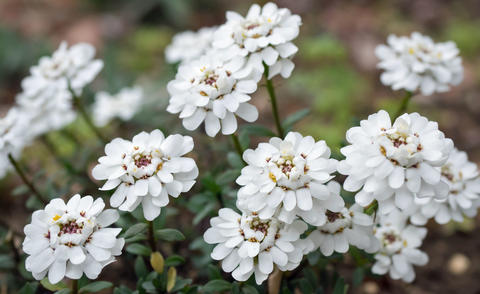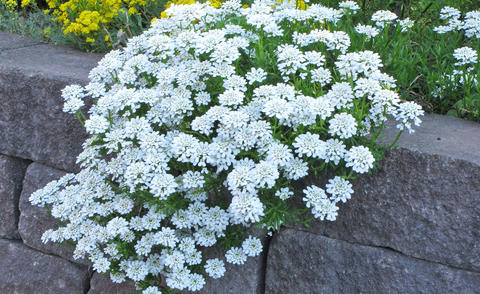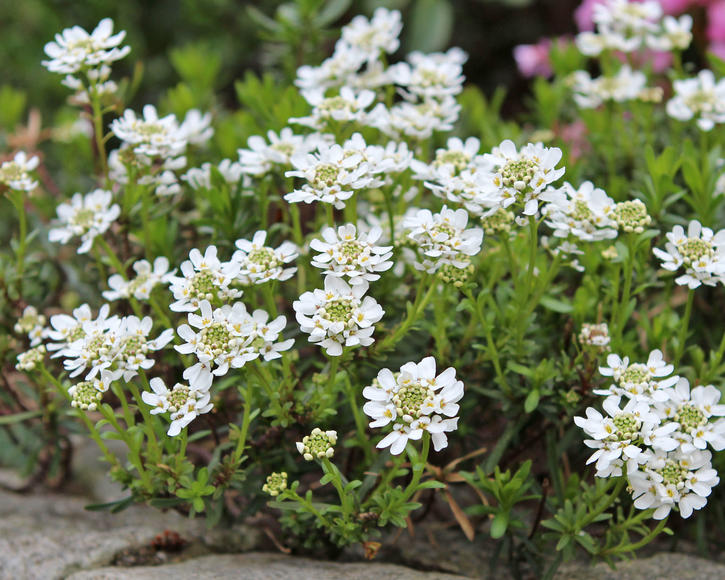Evergreen Candytuft
Candytuft is an essential perennial that shines brightly in sunny locations, requires little maintenance, and flowers tirelessly.
Factsheet
- Growth type
-
- Perennial plant
- Growth height (from)
- from 15 cm to 30 cm
- Growth width (from)
- from 15 cm to 40 cm
- Growth characteristics
-
- cushion-forming
- tight
- Flower color
-
- white
- Flowering time (month)
-
- April to May
- Flower shape
-
- Trumpets
- Leaf color
-
- green
- page format
-
- lancéolées
- Sheet properties
-
- evergreen
- Fruit shape
-
- pod
- Light
-
- sunny to scattered light
- Soil type
-
- stony to loamy
- Soil Moisture
-
- dry to moderately dry
- ph value
-
- weakly alkaline to weakly acidic
- Lime compatibility
-
- lime-tolerant
- Nutrient requirements
-
- moderately nutritious
- Humus
-
- low humus
- Decorative or utility value
-
- Flower Decoration
- Toxicity
-
- non-toxic
- Winter Hardness
-
- hardy
- Climate zones according to USDA
-
- 6
- areas of life
-
- ST1
- Use
-
- Group planting
- Planters
- Dry stone walls
- Garden style
-
- Stone Garden
- Pot garden
The genus Candytuft (Iberis) belongs to the large cruciferous plant family (Brassicaceae), comprising around 40 different species, including annuals, perennials, and dwarf shrubs. They are originally native to mountainous regions of southern Europe. From a gardening perspective, evergreen candytuft (Iberis sempervirens) is the most valuable as it is hardy in this part of the world.
Like all Candytufts, evergreen candytuft has a carpet-like growth habit and reaches heights of up to 12 inches, depending on the variety. As the name suggests, the popular rock garden plant has evergreen foliage (lat. sempervirens = evergreen).

The leathery, dark green leaves of candytuft are lanceolate and around 0.79 to 1.57 inches long.
All species of Iberis tend to have four-petaled flowers which resemble little ribbons. The bright white flowers of evergreen Candytuft sit in flattened, umbel-like inflorescences. Flowering is from the end of April to the end of May. Evergreen candytuft flowers turn a delicate pink as they fade. Other species of Iberis and some varieties of evergreen candytuft also flower in purple, red, and pink.

After flowering, the plants produce small ovate pods, each containing two winged seeds.
As a southerner, candytuft prefers full-sun locations, but evergreen species like Iberis sempervirens can also tolerate partial shade.
Evergreen Candytuft thrives in mineral sandy soils that are well-drained and calcareous. Candytuft tends to run riot if the humus and nutrient content is too high.
Candytuft can be planted and replanted throughout the spring and summer. Make sure not to plant Candytuft too close to its neighbors in the flower bed because it is sensitive to competition and grows considerably in width over time. A distance of at least 12 to 16 inches is ideal. For a thick cushion of flowers, you need around eight to ten plants per square meter.

As a rock garden plant, Candytuft prefers to be dry than wet, and therefore needs very little water. After flowering, cut back all shoots by about one half to two thirds their length so that the plants maintain their compact green cushions. Otherwise, the plants will age from the center outwards over time, as usually only the ends of the shoots have leaves. But do not prune Candytuft too late in the fall and never cut back to old wood. Evergreen Candytuft is generally frost resistant, however you should cover it with brushwood in winter so that it does not dry out in the sun. Fertilize once a year with compost to improve vitality.
Unlike many other rock garden plants, Candytuft cannot be divided as it has a thin and central main root.
Candytuft thrives in all types of rock garden, on wall tops, and also in pots and troughs. As they are not sensitive to pollution, they can be planted in city gardens. Other cushion plants that flower in spring, such as or moss phlox (Phlox subulata), are good companions. Small iris varieties and botanical tulips also go very well with candytuft.

The variety ‘Snow Cushion’ flowers early and freely. The snow-white cushion of ‘Snow Cushion’ grows 5.90 inches tall, including the flowers. They love sunny to partially shaded locations in well-drained soils. The flowers of the variety ‘Absolutely Amethyst’ have a pink-purple color that is very unusual for this species, but no less beautiful.
It is easy to propagate candytuft by taking approx. two inch long cuttings from shoots that are not flowering. Simply cut them off and put them in a partially shaded, wind-sheltered location in humus-rich, sufficiently moist soil. If you sprinkle humus on the lower shoots, they will also form roots. Candytuft also spreads prolifically by seed when the seeds are left to mature in the inflorescences.
Candytuft is occasionally susceptible to white rust, mildew, and leaf spot diseases. Pest infestations are, however, very uncommon. sometimes appear on candytuft, but even slugs avoid the plants.

